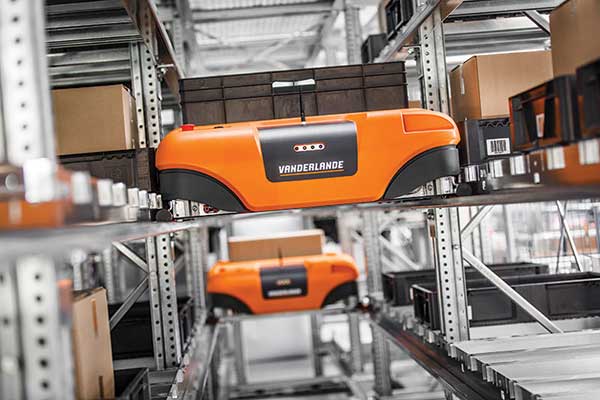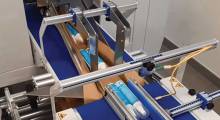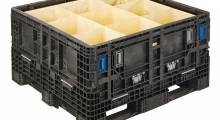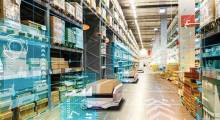Most of us have done this at least once.
You’re on the Amazon site, put something in your cart and go to checkout. There, you find that if you complete the order soon, it can be delivered that afternoon. So, you place the order, wait and wonder if Amazon can pull it off. Which, of course, it does.
In fact, Amazon has spent considerable effort and dollars to reconfigure its delivery network in the past couple of years to make these same-day deliveries commonplace.
While this sounds so, let’s say, Amazonian, it actually isn’t. And you know it. Rapid order turnaround is hardly confined to Amazon. In fact, we’re all rapidly coming to expect it. Clearly, the world is shifting.
At the same time, it’s important to note that compressed service levels are not confined to e-commerce. They’re spreading into commerce of all types and from business-to-consumer (B2C) to business-to-business (B2B).
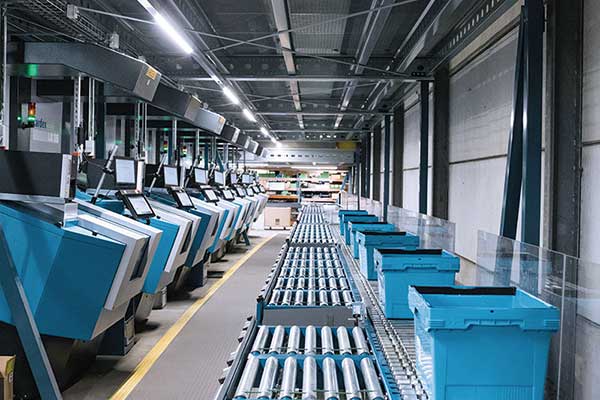
Small parts are stored in and picked from a bank of vertical buffer modules.
And that’s the world that all types of automated storage and retrieval systems (AS/RS) are adapting to. And they’re doing quite well at it—from mini- and unit-load systems to ultra-high density systems on a grid as well as vertical lift modules (VLMs) and carousels.
Tony Hasman, principal consultant in solution development at Dematic:
“The hot spot for AS/RS right now is a company’s service level requirements to complete orders in ever shorter time frames.”
And to make that happen, the focus of automated storage systems has shifted, too, explains Phil Zimmerman, principal consultant at Dematic. “Traditionally, throughput—how many loads an hour can be stored and retrieved—was top of mind. But now that has shifted to how much inventory is required to be in storage to support the throughput needed at any given time including peaks,” says Zimmerman. That’s a different equation.
In other words, automated storage not only needs to be highly responsive, but configured to stage and store a range of inventory including on peak days. That’s a tall order (not a unit load pun).
As we discovered talking to the two consultants from Dematic as well as other automated storage experts, this combination of requirements has had broad implications for AS/RS. Listen in.
The New Rules of AS/RS
For the longest time, AS/RS selection always came back to return on investment (ROI). And it still does. But not in the same way.
Today, the key word is labor. No surprise there.
That means an investment in automated storage “is not about years until payback, but can you run your business any other way right now and keep up with organic growth,” says Doug Card, manager of system and integrator sales at Kardex. “People do feel trapped here. Like they don’t have a choice but to make automated storage part of their mix,” adds Card.
By the way, expected payback a few years ago was in the three- to five-year range, says Hasman. “That has now expanded to six to eight years and sometimes even 10,” he says.
Ultimately, says Hasman, it often comes down to building a system that not only gets the job done, but offers the best ROI for the budget available. You might call it rightsizing AS/RS or managing peaks.
Part of that evaluation, says Dematic’s Hasman, is determining what inventory must be stored in automation or what can be handled elsewhere. Also, when you may need to add an extra shift.
Dematic’s Hasman:
“Most of the time, you don’t have to put everything in the automated system. You need to determine the overall slow movers that can actually be moved between different types of storage depending on activity levels at particular times. Ultimately, it’s a matter of plotting peak to average cycles and making plans for inventory management at key times. Then you need to determine which and how many days you can’t manage your peak without accommodation.”
Meanwhile, “automated storage now has more of an appeal to smaller companies than it has traditionally,” says Andy Lockhart, director of strategic engagement for Vanderlande, a Toyota Industries Company.
“Medium-sized companies, those with $250 million and higher, are now looking at automated storage,” says Lockhart.
He explains this shift as a perfect storm of, yes, labor and the pervasiveness of e-commerce, but also of customer service level requirements.
As Lockhart continues, it’s clear that automated storage has the ability to handle an ever-broader range of inventory configurations. Traditional pallet loads as well as totes are in there with mixed case handling as well as eaches.

A multi-shuttle system maximizes storage density and speed of inventory movement.
The Next Generation
In other words, there’s probably nothing the combined army of automated storage equipment can’t handle. But that has required a shift from being an integrated silo in a facility’s operations to an interactive, integrated component that supports a range of order fulfillment activities.
Ask Mario D’Cruz, vice president of markets and strategy at Swisslog, about examples of this new generation of automated storage solutions and he points to a new installation at the dm pharmacy chain near Berlin, Germany.
The focus, D’Cruz explains, is combining more than one form of automated storage in an integrated and fully interactive manner. Pallets are handled in a 24,000 high-bay AS/RS and a shuttle warehouse with 265,000 locations for smaller goods. They’re connected to eight manual and seven robotic pick cells.
The system also includes system control and visualization software as well as an automated case palletizing system.
“These are end-to-end solutions, not individual pieces of hardware,” D’Cruz explains. “And they all speed up processes, maximize storage density and increase throughput,” he adds.
Something similar is happening with VLMs and carousels, explains Card of Kardex. He says traditional installs here tap out with three or four machines handling MRO spare parts.
But that’s changing with eight or 10 carousels and VLMs teamed together for order fulfillment, often in e-commerce. Card says it’s not uncommon for a single machine to handle 100 orders simultaneously.
One system in particular stands out, he says. A Texas-based electronics supplier uses 150 VLMs. The first 54 installed, says Card, handled 80,000 lines a day. Floor space savings is notable, too. Going forward, Card says the facility could have as many as 300 VLMs in place filling orders.
Elsewhere on the automated storage front, Kardex has introduced its vertical buffer module (VBM). Card says that it’s essentially a small mini-load in a box that stores, picks and buffers small parts. It has a small footprint and can be installed in stand-alone mode or in small pods.
This next generation of AS/RS also includes ultra-high density grid systems such as those from AutoStore. Widely used, these systems run bots on top of a grid of vertical storage locations mounted on the floor. The bots store and retrieve smaller inventory such as fashion and tech items often as eaches. The systems can have a limited number of locations or many more, depending on need.
In fact, DHL and AutoStore have just announced an expansion of the third-party logistics provider’s use of these systems from Singapore to Germany and the United States. Currently, DHL has a total of 800,000 bins at nine locations. It will expand by four, elevating the total number of bins to 1.2 million.
DHL cites the system’s “ability to efficiently manage and optimize inventory using vastly reduced space within warehouses.” The modularity and scalability of the systems support shifts in both inventory handled and peaks.
Automated Storage Accessories
Lockhart at Vanderlande also talks about the flexibility the latest configurations of automated storage bring to processes.
For the longest time, AS/RS was thought of as being fairly monolithic and inflexible. In fact, Lockhart says automated storage is now being configured in ways that allow orders to be picked in advance, stored and then called for shipment when the appropriate time arrives. That’s a long way from store and receive.
And as you already suspect, upgrades to robotic aspects of automated storage are headliners here.
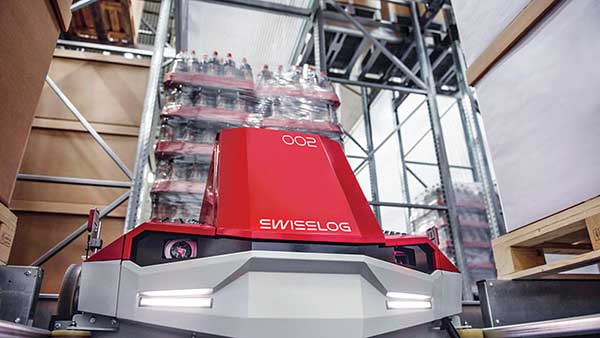
Automated shuttles transport pallets of soda.
For instance, D’Cruz talks about two new shuttle systems, one for cases (CycloneCarrier) and the other for pallets (PowerStore).
The latter is already in place at a Pepsi facility where its modularity has allowed a 60% increase in storage capacity. Meanwhile, the CycloneCarrier is at e-commerce company Alnatura for increased throughput and availability. Both are managed by SynQ warehouse management software.
The latter is already in place at a Pepsi facility where its modularity has allowed a 60% increase in storage capacity. Meanwhile, the CycloneCarrier is at e-commerce company Alnatura for increased throughput and availability. Both are managed by SynQ warehouse management software.
D’Cruz points out that the CycloneCarrier can serve as a buffer during peak times.
Meanwhile, Vanderlande offers ADAPTO, a roaming shuttle with advanced sortation and sequencing capabilities. It roams levels and aisles independently, allows for a smaller footprint and increases the storage capacity of DCs.
In addition, AutoStore introduced last month its R5 Pro bot. Its enhanced productivity features a promise to reduce by 15% the number of bots needed in a system. Enhanced routing efficiency is central to that.
But a different kind of robot is also now emerging. Some are autonomous mobile robots that bring inventory to and from storage structures. Others are armed picking robots that move inventory between stages in the order fulfillment process. Both are becoming an important part of the overall success of automated storage systems.
An example is Swisslog’s CarryPick goods-to-person solution. It consists of four components: mobile robots, mobile racks, pick stations and Swisslog’s SynQ warehouse management software. The solution fits perfectly into existing buildings and can be extended or even relocated on short notice.
As you can see, automated storage is morphing before our very eyes. So, it might be time to rethink where it might fit in your operations.
Article topics
Learn More
